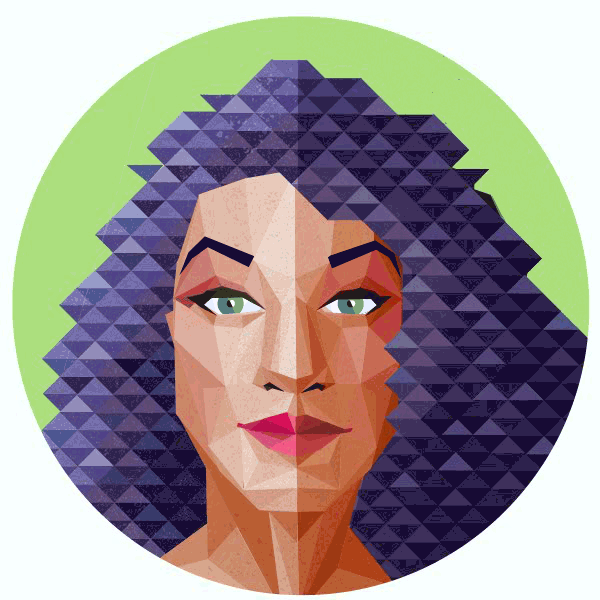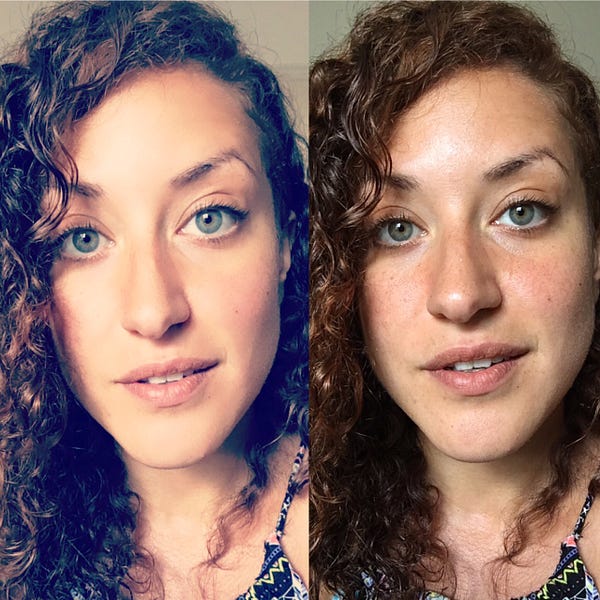
You can probably tell a woman’s generation by the thickness of her eyebrows. I
was a teen in the 90s, when a uniformly tweezed, slender arch was the
norm—and when you pluck that much you just aren’t going to get it back.
Now my natural brow’s not thick enough to be on trend. There’s been a
resurgence of the big brow, attributable mostly to Cara Delevigne, who was among the first wave of supermodels to make Instagram and other social media a core pillar of her publicity strategy.
Growing up, people my age got our makeup advice the same place we got our dubious sex tips: from glossy magazines. Back then, you did things — even ill-advised things like wearing a stick-on bindi or carrying an inflatable handbag — because
celebrities had done them, or because some words about the newest trend
had come down from on high, nebulous fashion authorities placing them
into a box quote in Elle magazine.
Today, we get our beauty instructions primarily from social media and a new sort of celebrity;
not the movie star or magazine editor, but the passionate consumer who
knows how to put on makeup so well that everyone wants to watch them on YouTube, follow them on Instagram, and look as boldly staged and beautiful as they do online.

Among the best new skills I’ve learned as an adult is how to do a basic “Instagram eyebrow.” The knowledge anchors me, tells me I’m not that old,
that I am keeping up. A search for “eyebrow tutorial” on YouTube brings
up more than half a million results, most of them young women in all
colors and nationalities creating the same dense, severe look. Every
month, over 50 million people watch
more than 1.6 billion minutes of consumer-uploaded beauty content on
the site. I’m one of those people, and can now approximate the brow on
myself, at least enough to feel all right showing my face in the club.
Imagine
a big eyebrow perfectly outlined in dark liner, filled in with powder.
The liner creates the illusion of a bigger, bolder brow than is natural,
while at the same time creating a stark frame for the eye. The bit of
the brow closest to the eye is blunt, even square-edged, and the rest
wings outward toward the temple in a clean, sharp-trending line. No
matter how many tutorials I follow, I’ll never quite be able to perform
the brow exactly. At its most correct, it should look as if it were
airbrushed on with a stencil. That’s the dream. That’s the Instagram
eyebrow.
Or,
at least that’s the most current understanding. There’s actually some
confusion about what the phrase “Instagram eyebrow” means, because it’s
changed some over the years. It can refer to the distinctive,
dark-powdered checkmark I’ve just described, now written almost daily on
the face of every makeup fan. Or, it can reference its meaning closer
to 2014, when the term caused a sensation—thanks
specifically to a “really frightening” brow fade of sorts at the inner
eye, an almost “ombre” effect where the tonality of the brow shifted as
it traveled to its thinnest point.
It
was around then that someone finally noticed a brow that looks on-trend
in a filtered photo looked very strange in real life. That was almost
irrelevant, though. How it looks on Instagram matters most, especially
as we are increasingly offloading our self-images onto social media. As
we spend more and more time online, the person you appear to be on
Instagram or Facebook could soon be more relevant to you, and more real
to other people, than whomever you are offline—if indeed you are ever
really offline.

Lately, my friends and I have rejoined Snapchat, lured in by the weird but fun filters that add animation overlays
or other modifications to selfie pictures and videos. Some of them are
intentionally absurd, like cartoon animal ears and noses. More
interesting, though, are the subtle effect-filters that make your eyes
just a little bit bigger and more luminous, your nose a shade smaller,
your skin soft-focused. My filtered self is beautiful in an unearthly
way. All my friends know I don’t look like that, sure, but what if that
isn’t the point?

The author with (left) and without (right) a Snapchat filter.
Some
futurists once believed that the whole web would become a world unto
itself, a true 3D environment where users would create full-body avatars
to act out “second lives” for them in virtual space. While that future
hasn’t exactly materialized, we
are building avatars, in a sense. And a viral culture of increasingly
bold and unusual beauty products has grown to serve these versions of
ourselves — a beauty culture increasingly genderless, unconcerned with appealing to patriarchy, and detached from the conventional fashion industry.
The
five Kardashian and Jenner sisters are masters of the Instagram
eyebrow; they make it look effortless. They are the perfect aspirational
figures for the Instagram era — we believe they are basically normal
people who have mastered the art of projecting a second self into the
social media realm with the help of some cutting-edge products and good
strategy. We feel both able and free to create a second self, too, to
participate joyfully in calculated selfie-craft, to make ourselves up
not as much for the outing itself as for the “‘grams” we’ll post. We
know that we’re all projecting an unreal image. We don’t mind.
The
Kardashians certainly helped bring contouring — a visual sculpting
technique formerly of Old Hollywood and, more recently, almost
exclusively the province of drag queens — into common parlance. Like the
Instagram brow, contouring can be severe, a look crafted to be photographed, not deconstructed.
It is a performance of one’s own face, one that can be turned up louder
and louder until the face has almost stylized itself. It’s just within
the last few years that I’ve suddenly begun to feel I was selling myself
short by owning only a sheer foundation or tinted moisturizer, and just
a little bronzer. So, I started doing the eyebrow. But after that I
needed a darker bronzer with which to whisk stark gutters underneath my
cheekbones. Then I got a concealer, and then a highlighter, two creams
both lighter than my face where the former is matte and hides blemishes,
and the latter is sheer and reflects light. I now own a veritable color
wheel of cream highlighters, each for different areas of my profile.
I started using foundation sponges for the first time in a nearly 20-year makeup-wearing career. I got a “Unicorn Tears WonderSponge”
as part of my Birchbox, a subscription beauty sample service I signed
up to based on a Facebook ad (no regrets). I started using primer, and
now I use a full-face primer as well as a primer just for my eyelids. I
have learned, basically, which parts of my face need to be matte and
which parts should glimmer subtly under light. It’s not that I think I
“need a lot of makeup” — that rhetoric, about needing
makeup, feels fusty — it’s that I want to be part of this new
performance of beauty, unconcerned with what the man on the street would
think of my look.

Beauty in the age of social media is about inhabiting a liminal performance space, about participating in performances led by trendsetters — where being a trendsetter may no longer require you to be skinny and white.
It’s often more about photographing innovations and color experiments
that create a sensation and make other people want to try them than it
is about what makes the most sense to wear to work.
This “gloss strobing” highlighter technique is designed for maximum luminosity in photos, while these bizarre geode-themed “crystal lips”
are probably meant only as Instagram art and not for going to lunch.
Bitter Lace Beauty’s rainbow highlighter palette (a swipe of the
shimmery powder appears like an actual rainbow of colors on your skin)
reportedly sold for over $1,000 on eBay when its launch earlier this
spring couldn’t meet initial demand. The soft prism of hues it enables
does look amazing in photos,
but I’ve never seen anyone wearing it on the streets of London, nor
even on the cover of a magazine. Just a few months later, “even hotter than rainbow highlighter”
was “thermal highlighter,” a high-shine, multicolored experiment
inspired by compiling shimmery eyeshadows to reflect what you might see
in a thermal-imaging body scan. Essentially, it gives faces the odd,
futuristic look of a heat map.
This
is makeup for its own sake, no more or less than plain delight in
performance and experimentation. It almost doesn’t matter that each
trend lasts only a few months, or that someone out there has spent a
thousand dollars on space unicorn makeup with few to no practical venues
for wearing it outside their home.
These
performances of our meatspace faces live only in social media feeds,
where it’s considered beautiful to sport thermal heat map faces, crystal
lips, and oddly dark, oddly perfect Instagram eyebrows. We aspire to be
a popular avatar — like a Kardashian — more than we aspire to a prior
age’s more conventional markers of achievement or beauty. Is it really
too far off to imagine that future makeup may even be crafted primarily
for our avatar faces, our real ones the afterthought? Or that soon
you’ll surely know a woman’s generation by the adornment of her online
face?
For the record, the beauty icon of my youth, Kate Moss of the heroin-chic figure and wispy eyebrow, did not join Instagram until last week.

This post is part of How We Get To Next’s Sartorial
month, looking at the future of fashion throughout September 2016. If
you liked this story, please click on the heart below to recommend it to
your friends.
Read more from How We Get To Next on www.brymond4u@blogspot.com
No comments:
Post a Comment